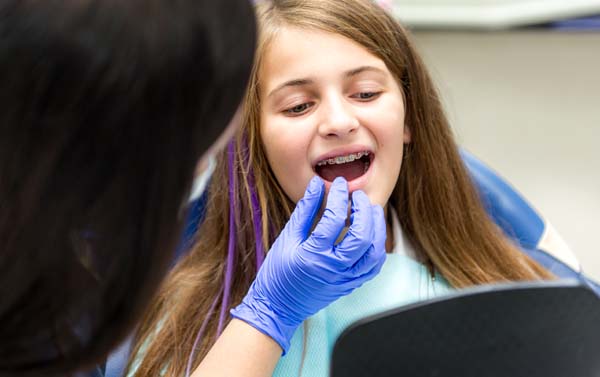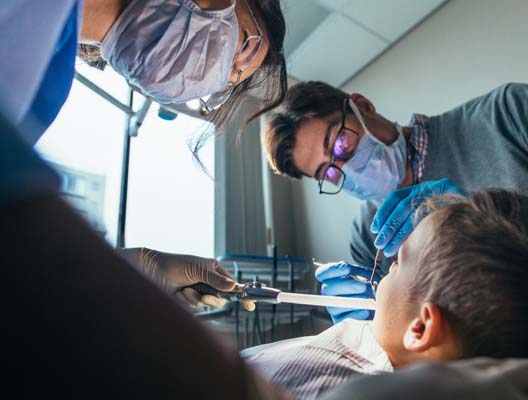3 Questions to Ask Your Pediatric Dentist About Children’s Braces

A pediatric dentist works with your child to treat their condition and teach them the importance of oral health from a young age. Misalignment and malocclusions are quite common in children and adolescents as their teeth develop. There are several reasons a child might require braces. Treating these conditions early on can help guide their teeth into proper alignment and enhance their appearance and oral function. Read on to learn more about children’s braces.
Questions to prepare a child for braces
Many children have crooked teeth or jaw and bite misalignment issues as their teeth grow and develop. Common oral health issues in children include crooked, overlapping, or overcrowded teeth or a "bad bite" known as a malocclusion. Malocclusions refer to overbites when the upper jaw protrudes over the lower jaw, while underbites refer to when the lower jaw protrudes over the upper jaw. Although children can benefit from being treated by a pediatric dentist for braces at any age, we recommend treatment once their permanent teeth start coming in (around age seven). This allows us to see their teeth and jaw placement and their development.
It is important for parents to discuss the treatment and its benefits with their children before seeking treatment. Prepare questions to ask the dentist and allow them to come up with their own. Common questions we receive include: What will my smile look like? What lifestyle changes will I need to make? Can I play sports? How long will my treatment last? How many dental visits will I need? A pediatric dentist can answer all of these questions and more during the initial consultation.
Questions about candidacy
During the first visit, we will conduct a physical examination and take necessary X-rays to examine the teeth, mouth, and jaw thoroughly. Some of the conditions we treat include:
- Being prone to biting the tongue, the roof of the mouth, or the inside of the cheek accidentally
- Breathing through the mouth
- Early or late loss of baby teeth
- Jaws that click or make other sounds
- Teeth that do not come together even when the mouth is shut completely
- Thumb-sucking or using a pacifier past the age of two
We will also ask the child questions about any symptoms they may be experiencing, whether they have difficulty chewing or swallowing, and if they ever hear a clicking or popping sound. These preliminary questions give us a better understanding of their condition and severity. We encourage patients to ask whether their case qualifies for orthodontic treatment and ask about alternative options if needed.
Questions about lifestyle changes
It is a good idea to discuss patients’ lifestyle and behavioral choices prior to treatment to understand the changes they may need to implement. Some questions we hear a lot include changes to diet, oral hygiene, and sports/physical activity. Patients can usually continue playing sports and other activities with their braces on. We will likely recommend or order that patients wear a mouthguard to protect their mouth and teeth while playing.
Book a consultation today
Braces treatment can help children and adolescents protect their teeth, improve their oral health, and enhance their appearance. Undergoing treatment at a young age saves them from dealing with extensive treatment during adulthood. Call our office at (310) 921-8333 to learn more or schedule an appointment.
To learn more about our services, visit https://www.myhawthorneorthodontist.com or call our Lawndale office at (310) 921-8333 to schedule an appointment.
Check out what others are saying about our dental services on Yelp: Pediatric Dentist in Lawndale, CA.
Recent Posts
Even though braces are common among teenagers, getting them is a new orthodontic experience for every patient. Teens and their parents tend to have many questions about braces and other orthodontic treatments for teens, when to get braces, and what having braces will be like. Here are some of the most common questions orthodontists hear…
Generally, a retainer is the last vital stage of orthodontic treatment. The appliance, made from metal and plastic, is personalized for each patient to fit perfectly into the wearer’s mouth. After braces or other orthodontic devices have corrected the alignment of the teeth, the retainer functions to stop them from shifting back to their previous…
Invisalign® is a common type of invisible braces that is developed by Align Technology. Many dentists around the world have used this treatment to fix dental problems. Invisalign is basically a removable orthodontic appliance. It is often offered as an alternative to traditional solutions. It is a good option for people who want a less…
Oral health is foundational to good overall health. Through the help of an orthodontist and bite correction, difficulties with chewing or speaking can be overcome. The inability to ingest food or clearly articulate impacts both physical and mental health. Bite correction has the potential to change the course of an individual’s health and wellness.Changes in…


